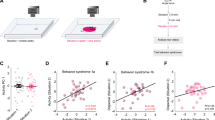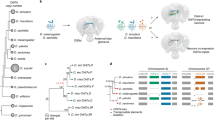Abstract
We combined transcriptional profiling and quantitative genetic analysis to elucidate the genetic architecture of olfactory behavior in Drosophila melanogaster. We applied whole-genome expression analysis to five coisogenic smell-impaired (smi) mutant lines and their control. We used analysis of variance to partition variation in transcript abundance between males and females and between smi genotypes and to determine the genotype-by-sex interaction. A total of 666 genes showed sexual dimorphism in transcript abundance, and 530 genes were coregulated in response to one or more smi mutations, showing considerable epistasis at the level of the transcriptome in response to single mutations. Quantitative complementation tests of mutations at these coregulated genes with the smi mutations showed that in most cases (67%) epistatic interactions for olfactory behavior mirrored epistasis at the level of transcription, thus identifying new candidate genes regulating olfactory behavior.
This is a preview of subscription content, access via your institution
Access options
Subscribe to this journal
Receive 12 print issues and online access
$209.00 per year
only $17.42 per issue
Buy this article
- Purchase on Springer Link
- Instant access to full article PDF
Prices may be subject to local taxes which are calculated during checkout





Similar content being viewed by others
References
Mackay, T.F.C. The genetic architecture of quantitative traits. Annu. Rev. Genet. 35, 303–339 (2001).
Sokolowski, M.B. Drosophila: genetics meets behaviour. Nat. Rev. Genet. 2, 879–890 (2001).
Ideker, T., Galitski, T. & Hood, L. A new approach to decoding life: systems biology. Annu. Rev. Genomics Hum Genet. 2, 343–372 (2001).
Anholt, R.R.H., Lyman, R.F. & Mackay, T.F.C. Effects of single P-element insertions on olfactory behavior in Drosophila melanogaster. Genetics 143, 293–301 (1996).
Fedorowicz, G.M., Fry, J.D., Anholt, R.R.H. & Mackay, T.F.C. Epistatic interactions between smell-impaired loci in Drosophila melanogaster. Genetics 148, 1885–1891 (1998).
Jin, W. et al. The contributions of sex, genotype and age to transcriptional variance in Drosophila melanogaster. Nat. Genet. 29, 389–395 (2001)
Fujii, S. & Amrein, H. Genes expressed in the Drosophila head reveal a role for fat cells in sex-specific physiology. EMBO J. 21, 5353–5363 (2002).
Wang, Q., Hasan, G. & Pikielny, C.W. Preferential expression of biotransformation enzymes in the olfactory organs of Drosophila melanogaster, the antennae. J. Biol. Chem. 274, 10309–10315 (1999).
Galindo, K. & Smith, D.P. A large family of divergent Drosophila odorant-binding proteins expressed in gustatory and olfactory sensilla. Genetics 159, 1059–1072 (2001).
Hekmat-Scafe, D.S., Scafe, C.R., McKinney, A.J. & Tanouye, M.A. Genome-wide analysis of the odorant-binding protein gene family in Drosophila melanogaster. Genome Res. 12, 1357–1369 (2002).
Kim, M.S., Repp, A. & Smith, D.P. LUSH odorant-binding protein mediates chemosensory responses to alcohols in Drosophila melanogaster. Genetics 150, 711–721 (1998).
Pikielny, C.W., Hasan, G., Rouyer, F. & Rosbash, M. Members of a family of Drosophila putative odorant-binding proteins are expressed in different subsets of olfactory hairs. Neuron 12, 35–49 (1994).
Kulkarni, N.H., Yamamoto, A., Robinson, K.O., Mackay, T.F.C. & Anholt, R.R.H. The DSC1 channel, encoded by the smi60E locus, contributes to odor-guided behavior in Drosophila melanogaster. Genetics 161, 1507–1516 (2002).
Störtkuhl, K.F., Hovemann, B.T. & Carlson, J.R. Olfactory adaptation depends on the Trp Ca2+ channel in Drosophila. J. Neurosci. 19, 4839–4846 (1999).
Vosshall, L.B., Wong, A.M. & Axel, R. An olfactory sensory map in the fly brain. Cell 102, 147–159 (2000).
Hultmark, D. Drosophila immunity: paths and patterns. Curr. Opin. Immunol. 15, 12–19 (2003).
Ganguly, I., Mackay, T.F.C. & Anholt, R.R.H. Scribble is essential for olfactory behavior in Drosophila melanogaster. Genetics, 164, 1447–1457 (2003).
Munier, A.I. et al. PVF2, a PDGF/VEGF-like growth factor, induces hemocyte proliferation in Drosophila larvae. EMBO Rep. 3, 1195–1200 (2002).
Igakura, T. et al. Roles of basigin, a member of the immunoglobulin superfamily, in behavior as to an irritating odor, lymphocyte response, and blood-brain barrier. Biochem. Biophys. Res. Commun. 224, 33–36 (1996).
Bilder, D. & Perrimon, N. Localization of apical epithelial determinants by the basolateral PDZ protein Scribble. Nature 403, 676–680 (2000).
Bilder, D., Li, M. & Perrimon, N. Cooperative regulation of cell polarity and growth by Drosophila tumor suppressors. Science 289, 113–116 (2000).
Roche, J.P., Packard, M.C., Moeckel-Cole, S. & Budnik, V. Regulation of synaptic plasticity and synaptic vesicle dynamics by the PDZ protein Scribble. J. Neurosci. 22, 6471–6479 (2002).
Wu, L.P., Choe, K.M., Lu, Y. & Anderson, K.V. Drosophila immunity: genes on the third chromosome required for the response to bacterial infection. Genetics 159, 189–199 (2001).
Wang, J.W., Soll, D.R. & Wu, C.F. Morphometric description of the wandering behavior in Drosophila larvae: a phenotypic analysis of K+ channel mutants. J. Neurogenet. 16, 45–63 (2002).
Raghavan, S. et al. Protein phosphatase 1β is required for the maintenance of muscle attachments. Curr. Biol. 10, 269–272 (2000).
Tracey, W.D., Wilson, R.I., Laurent G. & Benzer, S. painless, a Drosophila gene essential for nociception. Cell 113, 261–273 (2003).
Balakrishnan, R. & Rodrigues, V. The shaker and shaking-B genes specify elements in the processing of gustatory information in Drosophila melanogaster. J. Exp. Biol. 57, 161–181 (1991).
Kuniyoshi, H. et al. lingerer, a Drosophila gene involved in initiation and termination of copulation, encodes a set of novel cytoplasmic proteins. Genetics 162, 1775–1789 (2003).
Gaines, P., Tompkins, L., Woodard, C.T. & Carlson, J.R. quick-to-court, a Drosophila mutant with elevated levels of sexual behavior, is defective in a predicted coiled-coil protein. Genetics 154, 1627–1637 (2000).
Greenspan, R.J. The flexible genome. Nat. Rev. Genet. 2, 383–387 (2001).
Acknowledgements
This work was supported by the W. M. Keck Foundation and grants from the National Institutes of Health.
Author information
Authors and Affiliations
Corresponding author
Ethics declarations
Competing interests
The authors declare no competing financial interests.
Rights and permissions
About this article
Cite this article
Anholt, R., Dilda, C., Chang, S. et al. The genetic architecture of odor-guided behavior in Drosophila: epistasis and the transcriptome. Nat Genet 35, 180–184 (2003). https://doi.org/10.1038/ng1240
Received:
Accepted:
Published:
Issue Date:
DOI: https://doi.org/10.1038/ng1240
This article is cited by
-
Modulation of the Drosophila transcriptome by developmental exposure to alcohol
BMC Genomics (2022)
-
The Gene CG6767 Affects Olfactory Behavior in Drosophila melanogaster
Behavior Genetics (2019)
-
Transcriptomic Analysis of Aedes aegypti in Response to Mosquitocidal Bacillus thuringiensis LLP29 Toxin
Scientific Reports (2018)
-
Identification and preliminary characterization of chemosensory perception-associated proteins in the melon fly Bactrocera cucurbitae using RNA-seq
Scientific Reports (2016)
-
Changes Across Development Influence Visible and Cryptic Natural Variation of Drosophila melanogaster Olfactory Response
Evolutionary Biology (2016)



